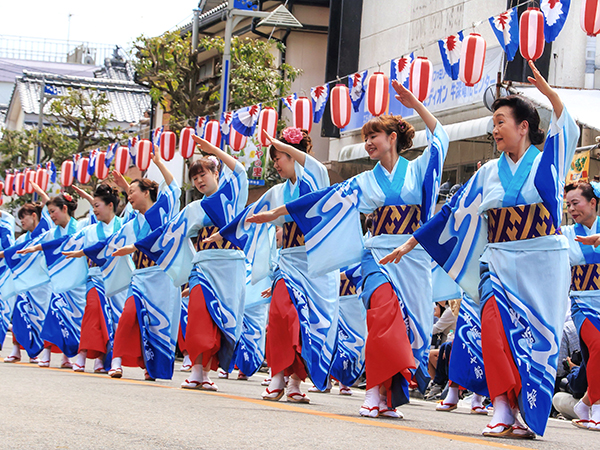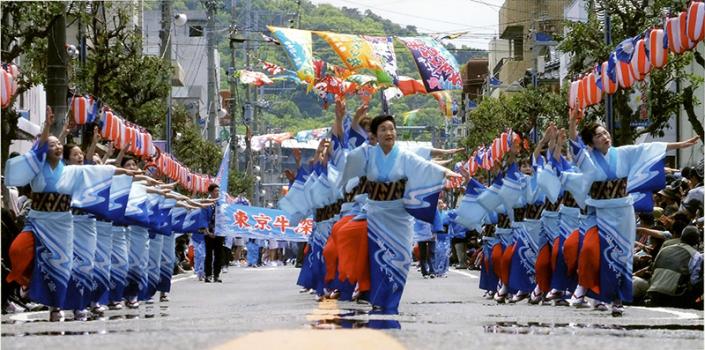Summer Haiya Festival: Celebrating Ushibuka’s Signature Folk Song
Few things are more reminiscent of a Japanese summer than the matsuri. Hate the sweltering daytime heat if you must, but summer festivals remain one of the most magical parts of summer. Who could fail to feel a rush of joy at donning a yukata (summer kimono) on a sultry evening, or excitement at hearing drums in the distance, the trilling, plaintive melodies of the bamboo flute and twanging shamisen soaring above the sounds of singing and laughter? It is a time for community and merriment, and above all is a way of keeping the traditional folk songs of Japan alive.
Each region in Japan has min’yo (traditional folk music) local to their area, but few can claim to be the originator of at least 40 other traditional songs around the country. The exception is, perhaps, Ushibuka and its signature song, Ushibuka Haiya Bushi.

The origins of Ushibuka Haiya Bushi
Located at the southern tip of the subtropical Amakusa Islands in Kyushu, Ushibuka was once a flourishing port in the Edo period (1603–1868), as well as Kumamoto Prefecture’s richest seafood production centre. Once an independent municipality, it was merged with a numbering of neighbouring towns and cities and subsumed into the new city of Amakusa.
Ushibuka Haiya Bushi––‘bushi’ simply meaning ‘melody’ in the context of min’yo––began life in the Edo period as a melody sung by local women to welcome and entertain visiting sailors, many of whom were seeking refuge from storms, waiting for favourable southern winds to blow in and allow them to sail north. These winds were locally known as ‘the winds of hae,’ and over time, it’s said that this morphed into ‘haeya’ and finally ‘haiya.’
The opening lyrics begin with references to the southern wind, and then in the manner of folk songs, quickly descend into drinking and general debauchery:
ハイヤエー ハイヤ ハイヤで今朝出した船はエー どこの港に サーマ 入れたやらエー
エーサ 牛深三度行きゃ三度裸 鍋釜売っても 酒盛りゃしてこい 戻りにゃ 本土瀬戸徒歩(かち)わたり
The ship that sailed this morning with the southern wind
What port did it end up in?
Visit Ushibuka three times, and you’ll be naked each time
Whether you’re selling pots or kettles
Come drink lots of sake
Walk back to Hondo Seto on the way
And return home over land
As is true of most orally transmitted folk songs, the exact number of verses remains unclear, and the order in which they are sung tends to vary. Nevertheless, it’s likely to be at least a dozen or more, often with equally fun, bawdy, or outright nonsensical lyrics. To wit:
ハイヤエーハイヤ ハンヤで半年ゃ暮らすエー 後の半年ゃ サーマ 寝て暮らすエー
エーサ どっから来たかい 薩摩から 碇も持たずによう来た様だい
We sing and dance the haiya half the year
Sleep and live the other six months
Where are you from––from Satsuma?
Why have you come here without any money?
ハイヤエー船は 出ていく帆掛けて走るエー 茶屋の娘が サーマ 出て招くエー
エーサ おーさやったとん 届いたかい 届いて煮て吸って 舌焼いたサイサイ
The ship raises its sails, departing without looking back
The young lady of the teahouse
Comes out, and beckons to the next customer
I sent you seaweed, has it arrived?
Yes it arrived––I cooked it, ate it, burned my tongue
ハイヤエーハイヤ ハンヤはどこでもやるがエー 牛深ハイヤが サーマ 元ハイヤエー
エーサ 川端石だい 起こせば蟹(がね)だい 蟹の生焼きゃ 食傷のもとだい 食傷蟹なら 色なし蟹だい
Oh the Haiya, the Haiya is performed everywhere in Japan
But the Ushibuka Haiya is the original Haiya
Lift up a river rock and you’ll find a crab
Grilled crabs give you food poisoning
Rotten crabs are the colourless ones
During the Edo Period, the helmsman of a ship was obliged to sing all night long––much like sea shanties in the British and American traditions––so singing songs learned at drinking parties was often a good way to while away the hours on deck. In this way, the sailors who had stopped by Ushibuka Port brought the song all over Japan on their travels, and in the manner of folk songs, had its melodies and lyrics adapted by local communities. Many extant haiya-style min’yo today, such as Awa Odori of Tokushima prefecture and Sado Okesa of Niigata Prefecture, owe their roots to Ushibuka Haiya Bushi.

Dancing the night away
The Amakusa Islands may have the dubious distinction of having Japan’s fastest depopulation rate, but you wouldn’t think it to see the sheer number of people attending its festivals. The Ushibuka Haiya Bushi is the focal point of the spring and summer festivals, the April festivities being the liveliest of them all. Entire streets are cleared, and crowds gather to watch men and women decked out in brightly-patterned happi and summer kimonos dance through the town. Anywhere from 3,000 to 5,000 dancers young and old take part in this yearly tradition, helping to keep this song and dance tradition alive.
Held towards the end of August, the Summer Haiya is just as festive in its own way, and preparations typically begin many months beforehand. Visitors wishing to join in need not fret, however. The Ushibuka Haiya Preservation Society holds dance workshops right before the Grand Haiya Dance held on both days. In this way, visitors can learn the moves and join in during the ‘tobiiri maru,’ a part of the parade where you can participate by literally ‘jumping in’ with the other dancers.
Ushibuka Haiya Bushi is at its heart a drinking song sung by sailors, so it’s no surprise the official choreography features many moves evoking actions you might see on a fishing boat, such as rowing a boat or drawing fishing nets in. It is relatively fast-paced and lively for a Japanese folk dance, and dancers typically keep their knees bent, ensuring their centre of gravity remains quite low. In extended versions of the choreography, the women dancers incorporate a tenugui (long hand towel) into their movements, knotting it loosely around the neck when not in use; and a pair of red clappers.
The workshops themselves are a lively affair. Watching them is rather reminiscent of martial arts training. Folk dancing veterans, typically older women, instruct the newcomers on the finer points of how to hold their arms in a particular pose, walking around and adjusting their postures. Don’t drop your arms! Bend your knees, turn your face up and look diagonally. Not to the side, diagonally! One, two, three, four, step out, pull in, walk, walk, walk, walk!

The colours of an Amakusa summer
One of the pleasures of watching the Ushibuka Haiya dance performance is looking at the distinctive costumes. The women are dressed in light blue and white summer kimonos decorated with swirling ocean wave patterns, an obvious nod to the origins of this folk song, and a pleasing visual complement to the swaying dance moves. An obi sash––typically purple and gold, though it may vary––holds the kimono together. Underneath, they wear a red koshimaki. This is a piece of cloth wrapped around their waist, which before the wider adoption of Western-style clothing would have acted as a kind of underwear. Here, it provides a bright contrast to the blue cloth above.
Like the women, the men may also wear yukata––predominantly white, rather than blue––held together with a gold and purple obi, although non-official dancers typically don a happi, a jacket worn at festivals. The men’s yukata is usually shorter than the women’s, and paired with handako (shorts). A nejiri hachimachi (twisted headband) adds a rakish, festival-appropriate touch to the whole outfit.
These festive summer days
Ushibuka Haiya Bushi may be the star of the festival, but the Summer Haiya is just as much of a community event, an opportunity for everyone to gather.
Early evening, just as the blazing heat of day softens to a sultry humidity, is the perfect time to head to the night market. Usually organised by the Ushibuka Shotengai Association, it’s the quintessential Japanese matsuri––stalls selling grilled oysters and syrupy shaved ice, families and children playing old-fashioned games involving plastic balls and hoops and goldfish, festival-goers sitting by the roadside with glasses of beer.
The community centre hosts live musical performances from Ushibuka locals. In contrast to traditional min’yo, the performers usually choose Japanese golden oldies, such as Yumi Matsutoya’s Yasashisa ni Tsutsumareta nara, or Sakamoto Kyu’s Ue wo Muite Arukou (popularly known as Sukiyaki in the Western world). It’s a chance for everyone to kick back, relax, and enjoy the music. The performances are then followed by a raffle. Who doesn’t fancy a chance at winning a bottle of sake, a bag of fruit, or (if you’re really lucky) a television?
Dancing the summer away
The grand event––a series of dance performances––is usually held at the Ushibuka Sōgō Center. Though it primarily revolves around the Ushibuka Haiya dances, interspersed between are shamisen performances and min’yo performed by folk music veterans. Any choice of min’yo almost always includes ‘Otemoyan,’ a famous Kumamoto classic featuring charmingly nonsensical lyrics. Other traditional folk dances also make an appearance, notably those whose origins are connected to Ushibuka Haiya Bushi.
Of these, the most famous must surely be the Awa Odori, Tokushima prefecture’s Bon Odori song. Indeed, the Awa Odori is also the largest dance festival in Japan, involving thousands of dancers citywide and attracting over a million visitors each year. The melody of the song is evocative of Ushibuka Haiya Bushi, though the lyrics are entirely different. If you missed the opportunity to visit Tokushima during their Bon Odori, the Summer Haiya usually has at least a few Awa Odori performances across both days of the festival––an excellent chance to see it performed up close and while you’re comfortably seated out of the sun!
The Awa Odori is instantly recognisable from the women dancers’ distinctive amigasa, half-moon-shaped hats made from woven rushes and straw. (One might observe they also resemble gyoza dumplings.) Otherwise, the yukata they wear varies by dance troupe, and might be predominantly red or pink. They typically have uchiwa (summer fans) tucked into the backs of their obi sashes.
The womens’ dance is remarkably graceful, characterised by swaying arms held high, the womens’ hands reaching towards the sky and moving in hypnotic, almost snake-like fashion. Unique to the dance is the way they stay permanently poised on the ends of their geta sandals, reminiscent of ballet dancers performing en pointe.
Two other dances worth highlighting are the Sado Okesa and the Ondeko, both usually performed by a visiting dance troupe from Sado Island. The former belongs to the sakamoriuta variety of min’yo (songs for drinking and gatherings) derived from Haiya-style songs. Both the melody and lyrics are rather melancholy, and the accompanying dance is appropriately stately and elegant.
Ondeko, on the other hand, is customarily performed as part of prayers for a good harvest or catch. There are around five different styles extant, but the Maehama style where two oni (usually demons, but in this case representing deities) dance, accompanied primarily by the taiko drum. The dance itself has a frenetic, frenzied energy distinct from the preceding festival dances. With their striking, brilliantly coloured costumes and long, wild hair, the masked demon dancers are usually an audience favourite at the festival.
Naturally, one must end the Summer Haiya Festival on a high note. Towards the end, the dancers of the Ushibuka Haiya Preservation Society emerge again for an encore performance. Finally, another rendition of Ushibuka Haiya provides the cue for all the other performers, including the Awa and Sado troupes, to join in the on-stage dancing––audience members welcome. It’s a merry, rousing finish to the summer festivities.
